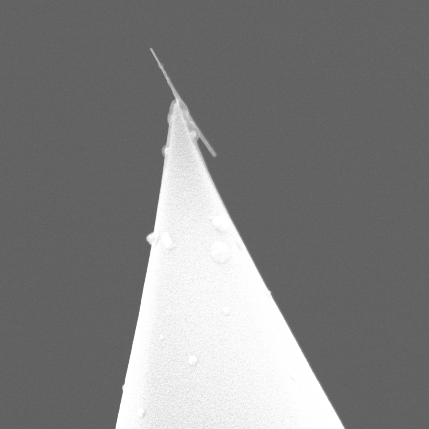Tip Modification
Carbon Nanotube (CNT) Attachment
We produce high aspect ratio tips by attaching a CNT to the end of the probe. By using a probe tip with a high aspect ratio, the sensitivity of the force sensor to interactions at the tip apex is increased, particularly when making dynamic measurements in liquid. High-aspect ratio tips reduce the hydrodynamic squeeze damping between the surface and the bulk of the tip. In addition, CNTs have unique mechanical and conduction properties from which we can benefit when using them as the probe tip.
Colloid Probe Attachment
By attaching colloidal particles to the end of a cantilever, we can modify both the surface chemistry and the interaction geometry, allowing investigation of the nature of colloidal interactions on the single particle-particle level. This is achieved by attaching the particles with a micromanipulator under and optical microscope using an epoxy. Colloid probes are then examined using the SEM for placement and sphere size before use.
Tip Functionalisation for Biomolecule Attachment
AFM is a useful tool for the investigation of molecular recognition events and binding interactions between biomolecular partners. The controlled immobilisation of biomolecules such as proteins, antibodies etc. onto AFM tips for subsequent interaction analysis, is generally achieved by the chemical modification of such tips. There are a wide variety of functionalisation methods available, many of which employ traditional chemical coupling strategies, and offer precise control over probe modification, in order to effectively anchor either ligands or receptors to tip surfaces. We employ various chemical modification strategies for tip functionalisation for biomolecule attachment and also modify tips with fluorescent entities such as quantum-dots, to allow visualisation of the tip under fluorescence conditions e.g. Confocal Microscopy.
Figure 2: A carbon nanotube attached to a AFM cantilever tip
Figure 2: A 5um colloidal sphere attached to a tipless cantilever
Figure 3: An example of cantilever functionalisation for biomolecule attachment.


